Revista Electrónica de Investigación Educativa
Vol. 19, Núm. 3, 2017
Analysis of Online Climate Change Games: Exploring Opportunities
Tania Ouariachi Peralta (*) ouariachi@correo.ugr.es
María Dolores Olvera Lobo (*) molvera@ugr.es
José Gutiérrez Pérez (*) jguti@ugr.es
(*) Universidad de Granada
(Received: March 7, 2016; accepted for publishing: May 2, 2016)
Cómo citar: Ouariachi, T., Olvera, M. D. y Gutiérrez, J. (2017). Analysis of online change games: exploring opportunities. Revista Electrónica de Investigación Educativa, 19(3), 101-114. https://doi.org/10.24320/redie.2017.19.3.1298
Abstract
Online games have been proposed as a promising tool for communication and education. Taking into account the new communicative paradigm of young people and the fact that climate change is one of the main threats to their future, this paper presents a checklist of indicators validated using the Delphi method to analyze the communicative elements of online climate change games targeting young people, and illustrates their use and usefulness with a qualitative analysis of a sample of games produced in Spain. This exploratory study maintains that online climate change games are shaping up to be innovative strategies, thanks to their immersive narrative and interactivity, among other features, which are used to meet the communicative and educational challenges regarding climate change: causes are made visible, actions are portrayed as local, uncertainty is avoided, contextualized information is provided in a positive and proactive tone, and a critical thinking approach is encouraged through decision-making.
Keywords: Gender, Professional choice, Teacher training.
I. Introduction
The fight against climate change requires a new form of social action in which young people are called upon to make a difference. If these young people are to protect their future planet from climate change, they should be knowledgeable on the topic and motivated to take climate-friendly actions. Despite the urgency of the matter, recent surveys on the perception of climate change in Europe show that knowledge of the issue is still limited and there is a notable lack of commitment to adopting measures to mitigate and adapt to climate change (European Commission, 2011).
Traditional education programs face challenges in adapting to teenagers’ information processing styles, which is why high schools are in search of ways to modernize their methods of knowledge transfer. With young people taken as the target sector of the population, it would be logical to put forward strategies that fit the new communicative paradigm of the "interactive generations" (Aguadez-Gómez, 2011) or the “digital natives” (Prensky, 2001), who have grown up in a world surrounded by computers, the Internet and video games, and have mastered concepts such as interaction, participation and collaboration.
The change in the mode of interaction means that existing communicative paradigms need to be revised and that there is a need to move towards new formats that facilitate a natural interaction between the person, the interface and the environment (Garrido-Miranda, 2013). Video games in general, and online games in particular, can offer this possibility. In fact, video games allow players to become involved in decision-making processes in past, present and future scenarios, and participate in the creation of the plot and therefore in the construction of the narrative, thus becoming “integral symbolic subjects” (Marcos & Satorum, 2014). For this and other reasons, video games have been proposed as a promising communication and education tool, able to strengthen learning in an interactive manner.
Online games may be implemented in educational contexts as a didactic tool for teachers: well-designed games foster skills and abilities, contribute to content development and enable learning experiences that are not possible in real life (Gee, 2004). Under the paradigm of “game-based learning”, several projects using online games to address climate change have been successfully implemented in high schools, considered key places for consuming information and reaching a young audience (Flora et al. 2014; Knol & De Vries, 2011). There is a strong interest in the educational community; however, teachers still lack information on the nature of these resources according to research carried out by the European Network for Growing Activity in Game-based learning in Education (ENGAGE).
Despite the increase in projects over the last decade, the field of online climate change gaming is still far from mature. A better understanding of the nature and communicative characteristics of games is needed. This could help teachers to decide on appropriate games as pedagogical resources. Although discussions have begun on the analysis of such games and several criteria have been proposed (Liarakou et al., 2012; Liu & Ding, 2009; Martí-Parreño et al., 2014), most sets of criteria focus only on pedagogical aspects, ignoring the communicative elements. We also observe how the majority of studies, initiatives and projects address English-speaking games and pay little attention to contributions in other languages, such as Spanish. This study aims to bridge these gaps.
Under these premises, and considering climate change as one of the main challenges facing humanity, and young people in particular, this article aims to a) present a checklist with validated analysis indicators; b) analyze the communicative elements of a sample of online climate change games, illustrating the use and usefulness of the proposed indicators; and c) explore the opportunities offered by these types of games for climate change communication and education among young people. To do this, we first address the importance of climate change communication and education, and then the concepts of climate change related to online games. Subsequently, we carry out a qualitative analysis of a representative sample of online climate change games produced in Spain, as a case study, in order to support our literature review and arguments with examples.
1.1 Climate change communication and education
Communication and education on climate change play an important role in the process of behavior and lifestyle change, and in translating the complexity of the problem and the need to intervene in several sectors. If environmental communication can be defined as exchanging messages to promote sustainable knowledge, attitudes and behaviors, pro-climate communication must address the exchanging of persuasive messages to promote pro-environmental actions aimed at reducing greenhouse gas emissions (Castro, 2010).
Several studies have confirmed that as of yet, most climate communication efforts have failed. This is not necessarily because little information is available; besides limitations in delivering information, scholars acknowledge the one-way transmission of messages, the lack of contextualization, and the negative and alarmist tone of the content (Aparici & Silva, 2012; Bienvenido et al., 2013; Cooper, 2011; Díaz-Nosti, 2013; Moser, 2010; Shafer, 2012). Authors like Sheppard (2012) have proposed a simple formula for effective climate change communication: (1) make it local, (2) make it visual, and (3) make it connected. This communicative approach must be taken into account in the design and development of education programs on climate change, which must address the conceptual understanding of the problem, awareness of the importance of the problem, and the need to take action to reduce greenhouse gas emissions.
Since the second half of the 20th century, the pedagogical model has drawn serious criticism because of its unidirectionality, based on communicative models that form a division between the transmitter and receiver of the information (Aparici & Silva, 2012). Broadly, the literature suggests that future education efforts include interactive learning and the consideration of individuals within their socio-cultural contexts (Cordero, Todd, & Abellera, 2008; McKenzie-Mohr, 2008). In addition, there is a need to add a critical approach to environmental education, opening up spaces for reflection and debates on possible alternatives for lifestyle changes (Cooper, 2011; Michael & Savill-Smith, 2004). Climate change education that includes awareness, knowledge, skills, values and opportunities for participation can therefore bring about in-depth learning.
1.2 Defining online climate change games
Unlike in television or cinema, where the viewer is simply a passive consumer of information, in video games the user plays and experiences for him or herself different roles through characters or avatars from perspectives that would otherwise be impossible. For video games, we retain the definition by Tejeiro & Pelegrina (2003), who describe them as electronic games that use computer technology and allow a player to interact with the machine in real time, and in which action takes place in a visual format. Online games, on the other hand, are a type of video game with a unique feature in that they are accessed via a web browser and are available on the Internet. In this paper we will use the terms video games and online games interchangeably.
Despite the fact that some authors do not include educational video games (for teaching and learning purposes) within video games (for recreational purposes), in this paper it is held that in educational video games the recreational component is ever greater, which is why they should be considered as such. Gamers intend to have fun and be entertained, but at the same time they are developing abilities and acquiring knowledge, particularly when the theme of the game is serious, as is the case with climate change. These types of video games, which go beyond fun and involve communicative and educational purposes, have also been called “serious games” (Katsaliaki & Mustafee, 2014).
Therefore, when talking about “online climate change games”, we are focusing on games specifically themed around climate change with communicative and educational purposes that involve fun and entertainment, and which are available on the Internet. These games usually have communicative objectives such as a) developing familiarity with and knowledge of the topic, b) raising awareness of causes and consequences, c) stirring up emotions and reflection, d) stimulating the development of ideas and solutions and e) promoting a change in attitudes and behavior. These games usually fall under the category of individual, or single-player games, in contrast to social games, such as card games, social network games, board games, multiplayer video games and alternate reality games, which involve social interaction between players (Aichner & Jacob, 2015).
As can be inferred from the definitions above, we are dealing with a digital environment characterized by two fundamental aspects: interactivity and immersion. Whereas interactivity can be thought of as a conjunction between sequentiality (a basic characteristic of computers when they execute a series of commands) and participation (ability to cause behaviors that intervene to modify these sequential processes), immersion can be defined as “the part that allows us to add dramatic aspects to our relationship with the computer” (Murray, 1999, quoted in Grifeau, 2013, p.109).
II. Methodology
Online climate change games on the web were compiled, selected and analyzed making use of a checklist with validated analysis indicators. The analysis of the sample of games not only helps to have a better idea of the nature and communicative characteristics of online climate change games, and how they may contribute to effective communication and education in young people, but also helps to illustrate the use and usefulness of the validated analysis indicators. Following a qualitative methodology, below we describe the steps and the instruments used:
In order to obtain information on online climate change games in a systematic manner, a data collection checklist was drawn up. First, analysis indicators were identified through a bibliographic review (European SchoolNet, 2009; Grifeau, 2012; Katsaliaki, 2014; Lacasa 2011; Meira-Cartea, 2007; Moser, 2011; Pérez-Latorre, 2010; Piñuel-Raigada., 2013; Reckien and Eisenack, 2013; Werbach, 2012). These analysis indicators were divided into four dimensions: identification (features that help identify and locate the game); narrative (analysis of the narrative and expository structures); content (analysis of the content and messages transmitted about climate change); and gameplay (analysis of the game design and how this creates meaning).
The division of the indicators in these four dimensions is modeled on the “Analysis Model for the Social Discourse of Video Games” by Pérez-Latorre (2010). This perspective encompasses a narratological view of games, which sees this medium as a form of narrative and a way of telling stories, and also a ludological view, which takes into account the rhetoric that conceals the design of the dynamics, mechanisms and elements of the game and how its design creates meaning.
Second, in order to validate the checklist, the analysis indicators were shared, via e-mail, with a panel of 13 experts from Spain, Latin America and the USA in the fields of climate change, scientific communication, journalism, environmental education and video games, so they could give their opinion on the relevance, use and usefulness of the indicators. They were selected for their theoretical and practical expertise, their motivation and approachability.
In this process, we made use of the Delphi technique, a systematic and interactive process aiming to obtain group opinions and consensus (Scapolo & Miles, 2006). In our case, three consulting cycles were sufficient: in the first round, an open-ended question was sent to the experts to assess the preliminary checklist with indicators identified through the literature review, and to propose new indicators; in the second round, a closed-ended questionnaire was used to assess the usefulness of each of the items in ordinal terms (high, medium and low); and finally, an open-ended question was posed to the experts to confirm their position. The level of saturation was established by the consensus (90% between medium and high usefulness) and stability of the results.
For the purpose of this study, the following indicators were selected for the checklist through the Delphi technique.
Table I. Dimensions and analysis indicators in the checklist

2.1 Compilation, selection and analysis of games
A web search was carried out during the period from August to December 2015 in the main search engines using the following search request: (“video game” OR “online game” OR “educational game” OR “eco-game”) AND (“climate change” OR “global warming” OR “sustainability” OR “environment”), in Spanish. Particular emphasis was placed on searching climate change-related government and NGO directories, as well as websites specializing in education 2.0 and video games.
In order to identify a sample of online climate change games produced in Spain, with a medium-high level of interactivity and a meaningful climate change storyline, the following requirements were taken into account: they had to be hosted on a web platform and be free to access; they had to be played over the Internet; they had to have communicative and educational objectives; the focus of the storyline had to be climate change, thereby excluding games in which this is an additional or secondary aspect in topics that cross over with climate change – recycling, energy efficiency, sustainability; and they had to target an adolescent audience (12+). In addition, snowball interviews with key users from online video game communities were conducted to identify the following games: 1. Actúa con tu consumo / Act on your consumption; 2. Alerta CO2 / CO2 Alert; 3. Climántica; 4. Misión posible, salvar el planeta / Mission possible, save the planet; 5. My Green Energy Planet. These games would fall under the category of individual games because they are single-player games, as was explained earlier.
Taking into account that the subject matter is video games, two researchers took part in the coding of the material, making use of table I. Levels, missions and episodes were used as analysis units, similar to scenes in movies or strip-frames in comics. In complex games, the researchers had to play the game several times to record data in a proper manner.
III. Results
By making use of the analysis indicators shown in table I, we begin a qualitative analysis to explore the communicative elements of a sample of games produced in Spain, while illustrating the use and usefulness of the indicators. The main observations are as follows:
First, our analysis of the identification dimension (table II) shows that NGO are the main contributors in charge of releasing games and producing messages. When looking at the communicative purpose, most games aim to develop familiarity with the topic, followed by raising awareness on causes and consequences, promoting attitude changes, and lastly, promoting the development of ideas and solutions for climate change through creativity. It is particularly interesting to consider the way this last purpose is accomplished in the game Act on your consumption, where the character Eva suggests that the player look around to check how many items are made of plastic in order to encourage the player to reflect upon how they could be replaced. She also encourages the player to write down his or her own plans for a sustainable diet and low-CO2 mobility.
Table II. Findings for the identification dimension
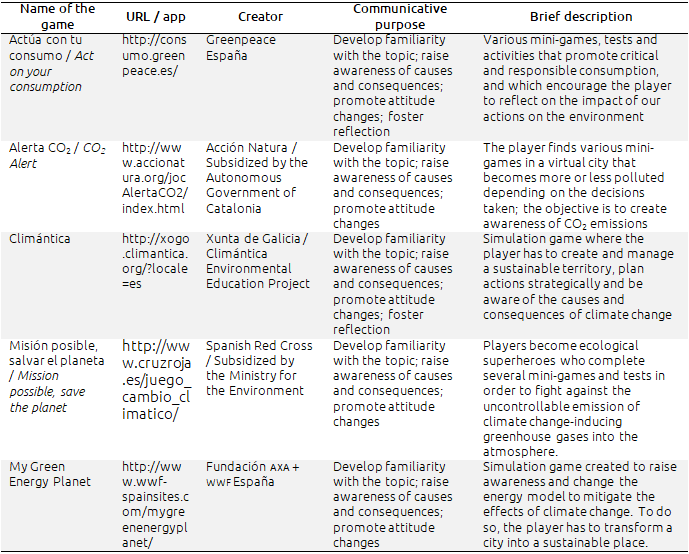
Secondly, from the qualitative analysis of our sample we observe very diverse storylines, character depictions and representations of environments (table III). For instance, in the game Alert CO2, the players play the role of normal citizens and are placed in the fictitious city of Metropolis, where they can choose between different scenarios, such as roads, schools or houses, where CO2 emissions need to be reduced, and the player must work quickly to stop global warming through tests based on questions and other skills. These tests are timed and the player has to take decisions under time pressure. Similarly, in the game Act on your consumption, the player plays the role of an ordinary teenager and wanders through different settings in the city, such as a supermarket, a house, a youth center or a road, choosing between different areas in which to explore the impact of our consumption habits and actions on the environment through a series of activities.
In Climántica, the player decides to leave for a new territory and can choose between an inland territory, a rugged territory that gives way to the open sea, and a coastal territory. This first choice allows the user to place him or herself in a meaningful location, thereby adapting communication to the user's own context and interests. In the area chosen, the player becomes the mayor of a sustainable territory and creates houses and work for the population, builds leisure areas, experiments with energy, decodes messages, overcomes skill-based tasks and, above all, controls pollution and climate change; as in Alert CO2, the player begins the game in present times, and time continues during the game until the player finds himself in the year 2050 and is able to see the consequences of his or her actions in the past.
Table III. Findings for the narrative dimension
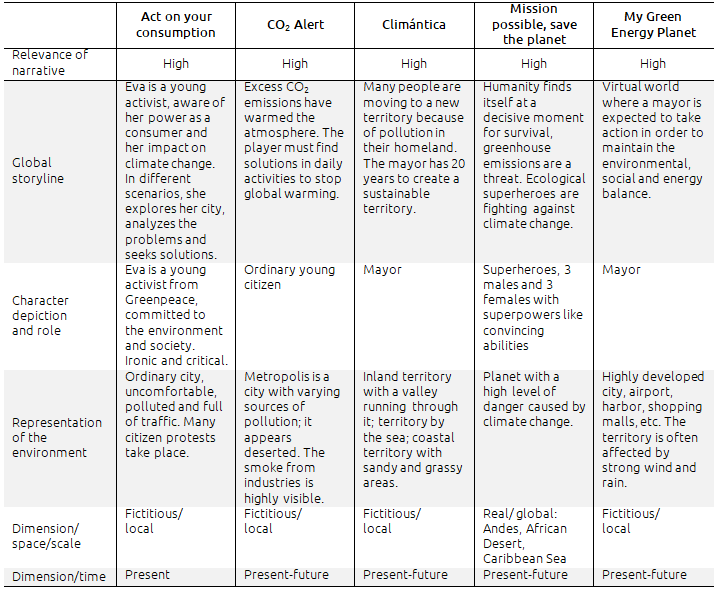
Despite the diversity of storylines in the games, all games tend to provide a better description of the environments than of the characters, partly because of the nature of the topic of climate change. One trend observed is the use of local discourse: a general preference towards portraying an ordinary citizen and focusing on the local scale. Players must make decisions at home or within their communities to reduce carbon emissions. Using present-day discourse is another trend, albeit with lots of references to the future. Through this present-future connection, online games offer opportunities to convey to young people the problems that they will face in the future and enable them to experience these problems directly through the game.
The third dimension of the checklist (table IV) places emphasis on the content of the story itself, and this analysis of the communicative characteristics of our sample of online games illustrates the capacity of these communication tools to frame the story in a different way to conventional media, by addressing topics such as consumption, citizen mobilization, and solidarity. In fact, consumption and limits to the growth of our system are aspects that traditional media have not been able to exploit in terms of the information coverage regarding climate change, perhaps due to the fact that the media itself is part of the central core of this system in crisis, as stated by Díaz-Nosty (2013).
In the games analyzed, we have found some references and actions promoted to support a less consumerist society that eats less meat, consumes products from local stores and farmers, and shops for products labeled environmentally-friendly. Consumption is at the end of a chain of many problems related to the environment in general, and to climate change in particular (Gónzalez-Gaudiano & Meira-Cartea, 2009).
Table IV. Findings for the contents dimension
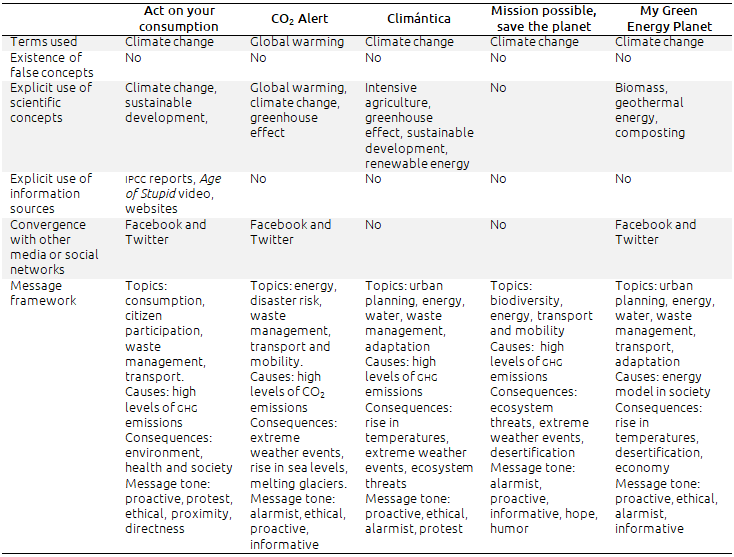
Not only do video games allow players to immerse themselves in a virtual world with thematic frameworks different to those offered by traditional media, but the games analyzed also provide stories with more context, causes and consequences. They have an alarmist, but also proactive, hopeful and positive tone, avoiding uncertainty and sensationalism. Here are a couple of examples that represent common message tones:
- Pro-action: “Act quickly, your decisions can reduce CO2” (CO2 Alert)
- Directness: “Hi, my name is Eva, I’m a young consumer like you” (Act on your consumption)
The messages they send out emphasize solutions, promoting individual action such as the use of bicycles, renewable energy and energy-saving light bulbs, waste management, buying unpacked goods or organizing citizen movements. Thus, the common conception that our personal action is irrelevant, given the scale of the problem and collective inaction, is replaced by the conviction that without the involvement of everyone adopting individual changes, taking part in the search for collective solutions and demanding changes to structural climate change policies, it will be difficult to make effective changes (Meira-Cartea, 2008).
It is also worth noting 1) the preference among game creators for the term “climate change” over “global warming”; according to British journalist Steven Poole’s book Unspeak (Poole, 2006), which investigates the manipulative power of language, climate change is a “less threatening” way of saying global warming and “less obviously” related to the oil industry; 2) the explicit use of scientific concepts, which can be of great use when using the games as a didactic tool in class.
The game Act on your consumption presents another significant opportunity for interaction created by online games: convergence with other media and social networks over the Internet. This virtual world includes links to Facebook and Twitter, websites with additional information, the documentary The Age of Stupid, extracts from the press, among other features.
The gameplay demonstrates important communicative features (table IV). For instance, our findings on game dynamics reveal that discovery and challenge, through decision-making and time pressure, are some of the most common strategies, and the player is portrayed as an explorer or creator. In fact, decision-making under time pressure is considered a key skill in coping with the effects of climate change (figure 1).
Figure 1. Example of decision-making under time pressure in Mission possible, save the planet
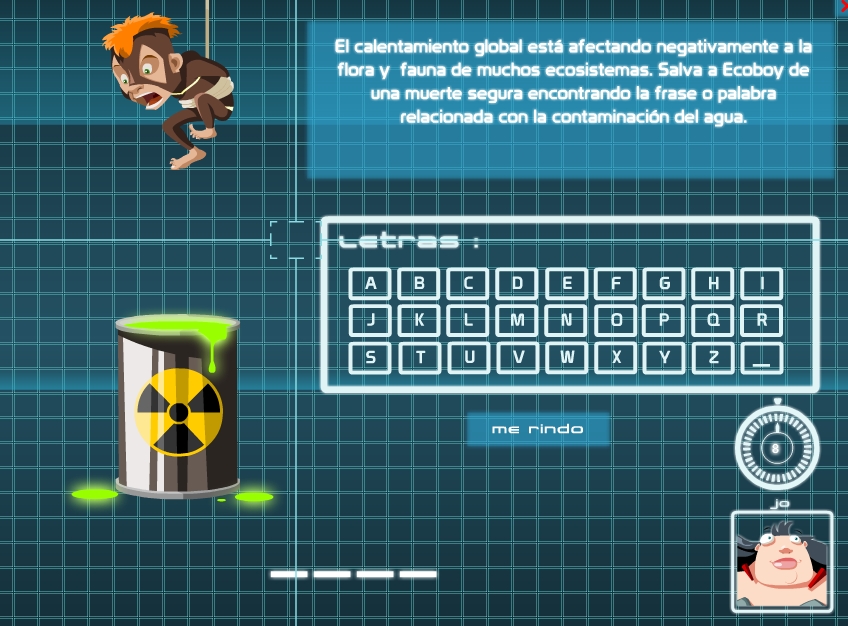
Players must take various parameters into account in real time, prioritizing considerations and planning resources in a strategic way, by analyzing and evaluating information received critically on important considerations such as urban planning, energy, pollution or water management.
Table V. Findings for the gameplay dimension
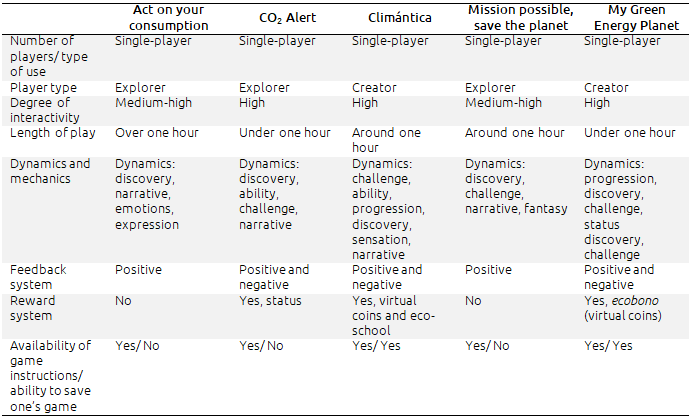
An analysis of the feedback and reward system reveals the prevalence of positive discourse (figure 2).
Figure 2. Praise after taking the right decision in Climántica
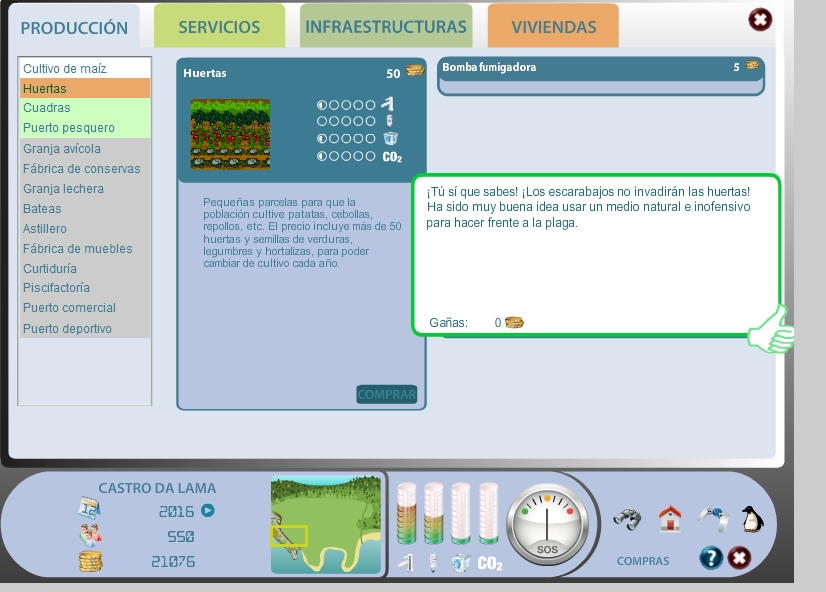
Rewards can act as motivators to take actions. Similarly, intangible rewards (extra points, virtual goods) are awarded upon answering a quiz question correctly (as in Mission possible, save the planet or in Act on your consumption), making sustainable decisions under time pressure (Climántica or My Green Planet) or doing well in the puzzle games, whether it is by turning the street lights off quickly or by matching the cause/consequence images of climate change (CO2 Alert).
IV. Discussion
In this paper we have proposed validated indicators to analyze the communicative elements of online climate change games, using a narratology and ludology perspective, and we have put them into practice, revealing their nature and some of the opportunities they offer for climate change communication and education in adolescents. Online climate change games, especially simulations, are shaping up to be innovative strategies, by meeting the communicative and educational challenges regarding climate change: causes are made visible, actions are portrayed as local, uncertainty is avoided, contextualized information is provided in a positive and pro-active tone, and a critical thinking approach is encouraged.
Thanks to their immersive narrative and interactivity, among other analyzed features, games have the capacity to convey to young people the problems that they will be facing in the future and enable them to experience these problems directly through the game, generally by adopting the roles of characters who have to be able to make sustainable decisions. It has been shown how narratives offer the player a range of possibilities at the same time, and it is the players themselves who decide in what order to establish them. The degree of interactivity, defined as the player’s intervention in the game content, and the very design of the game (personification, feedback, and rewards) play a very important part in the immersion process, to the extent of "negotiating" the players' own journey in the game.
In this respect, we consider personification in games to be an opportunity for climate change communication and education, giving players the option to take on the roles of certain characters, play an active role and be more than mere consumers of information (López, Encabo & Jerez, 2011). Subjectivity strengthens the impression that the player "exists" in the world, and that I am "me" in the game. In the game Mission possible, save the planet, the players become ecological superheroes via avatars that fight against uncontrolled gas emissions that cause climate change in the atmosphere. In the simulation games Climántica or My Green Planet, young people go deep into a virtual world and take on the roles of characters who have to manage an area and achieve an environmental, energetic and social balance. They do this by analyzing and evaluating information received to make decisions on important issues such as urban planning, energy, pollution or water management.
It can be said that the games analyzed seem to have incorporated the formula by Sheppard (2012) that was presented at the beginning of this paper: make it local, visual and connected. Although video games are not a panacea, there is a need to pay more attention to these communication tools, especially to the simulation formats, which according to our analysis seem to have a higher level of interactivity and immersive narrative.
V. Conclusion
Although our analysis of a sample of online climate change games produced in Spain is not by any means exhaustive, we do intend to contribute a preliminary approach to an emerging subject matter, and overall, to offer a valuable methodological tool that can help to analyze online games in this and other fields of knowledge before evaluating their impact on users. The dimensions and indicators proposed for analysis may be transferable to research on other types of online games in general, but especially those centered on scientific and environmental areas such as biodiversity, conservation, natural resource management or environmental problems associated with water, waste or mobility. As shown in this paper, these indicators help to understand the nature and communicative characteristics of online games, which is an important first step before deciding which games are appropriate to use as pedagogical resources.
Therefore, we would like to encourage academics and teachers to make use of the checklist proposed in this paper to analyze not only online climate change games in other countries and in other languages in order to make comparisons and draw conclusions at a global level, but also online games on other topics.
A clear future line of research would be to study the efficacy and impact of the five games selected in this paper on users’ learning and education. In addition, other lines of research should focus on the narratives that generate most interest in young people, the scientific rigor of the content, and the effectiveness of games in changing attitudes and behavior. Furthermore, taking into account the fact that "serious games" of this type manage to set out complex concepts in a dynamic manner in 15 minutes, another open line of research is how these tools can be applied in educational contexts.
References
Aguaded-Gómez, I. (2011). Niños y adolescentes: nuevas generaciones interactivas. Comunicar 36(XVIII), 7-8. http://dx.doi.org/10.3916/C36-2011-01-01
Aichner, T. & Jacob, F. (2015). Measuring the degree of corporate social media use. International Journal of Market Research, 57(2), 257-275.
Aparici, R. & Silva, M. (2012). Pedagogía de la Interactividad. Comunicar, 38(XIX), 51-58. doi:10.3916/C38-2012-02-05
Bienvenido et al. (2013). El periodismo ante el cambio climático. Nuevas perspectivas y retos. Barcelona: UOC.
Cooper, C. B. (2011). media literacy as a key strategy towards improving public acceptance of climate change science. BioScience, 61(3), 231-237. http://dx.doi.org/10.1525/bio.2011.61.3.8
Cordero, E., Todd, A. & Abellera, D. (2008). Climate change education and the ecological footprint. American Meteorological Society, 89, 865-872. http://dx.doi.org/10.1175/2007BAMS2432.1
De Vries, P.W. & Knowl, E. (2011). EnerCities, a serious game to stimulate sustainability and energy conservation: preliminary results. eLearning Papers, 25. Retrieved from http://papers.ssrn.com/sol3/papers.cfm?abstract_id=1866206
Díaz-Nosty, B. (2013). Aproximación a la construcción interdisciplinar y de un nuevo paradigma. Comunicación, cambio climático y crisis sistemática. Razón y Palabra, 84. doi: 10.4185/RLCS-64-2009-808-99-119
European SchoolNet. (2009). How are digital games used in schools. Brussels: European Schoolnet. Retrieved from http://games.eun.org/upload/gis-full_report_en.pdf
European Commission. (2011). Climate Change Eurobarometer (Report, Special Eurobarometer 372). Retrieved from http://ec.europa.eu/public_opinion/archives/ebs/ebs_372_en.pdf
Escribano, F. (2012). Jóvenes y videojuegos. Estado del arte. Revista de Estudios de Juventud, 98, 9-23. Retrieved from http://ojs.lib.swin.edu.au/index.php/fdo
Fischoff, B. (2013). The science of science communication. In A. M. Sackler Colloquium of the National Academy of Sciences. Washington: National Academy of Sciences.
Garrido, J. M. (2013). ¿Por qué los estudiantes juegan con videojuegos de estrategia?: algunos principios para la enseñanza. Revista Electrónica de Investigación Educativa, 15(1), 62-74. Retrieved from http://redie.uabc.mx/redie/article/view/330
Gee, J.P. (2004). Lo que nos enseñan los videojuegos sobre el aprendizaje y el alfabetismo. Archidona: Aljibe.
Gónzalez-Gaudiano, E. & Meira-Cartea, P. (2009). Educación, comunicación y cambio climático. Resistencias para la acción social responsable. Trayectorias, 11(29), 7-37. Retrieved from http://trayectorias.uanl.mx/29/
Grifeu, A. (2010). El documental interactivo. Evolución, caracterización y perspectivas de desarrollo. Barcelona: Editorial UOC.
Grifeau, A. (2013). El documental interactivo como nuevo género audiovisual. Estudio de la aparición del Nuevo género, aproximación a su definición y propuesta de taxonomía y de modelo de análisis a efectos de evaluación, diseño y producción. Doctoral dissertation,
Universidad Pompeu Fabra. Retrieved from http://www.doc.ubi.pt/14/teses_arnau_castells.pdf
Katsaliaki, K. & Mustafee, N. (2014). Edutainment for sustainable development: a survey of games in the field. Simulation & Gaming, 1(26). http://dx.doi.org/10.1177/1046878114552166
Lacasa, P. (2011). Los videojuegos: aprender en mundos reales y virtuales. Madrid: Ediciones Morata.
López-Valero, A., Encabo-Fernández, E. & Jerez-Martínez, I (2011). Competencia digital y literacidad: nuevos formatos narrativos en el videojuego «Dragon Age: Orígenes». Comunicar, 36(XVIII), 165-171. doi: 10.3916/C36-2011-03-08
Marcos, M. & Satorum, M. (2014). La narración del videojuego como lugar para el aprendizaje inmersivo. Revista de Estudios de Juventud, 98, 77-89. Retrieved from http://www.injuve.es/sites/default/files/2012/46/publicaciones/Revista98_6.pdf
Martí-Parreño, J., Méndez-Ibáñez, E., Giménez-Fita, E. & Queiro-Ameijeiras, C. (2015). El uso de la gamificación en la educación superior: propuesta de una ficha de análisis ludológico-narratológico. In M.A Ruiz (Ed.), XII Jornadas Internacionales de Innovación Universitaria
Educar para transformar: Aprendizaje experiencial (pp. 103-111). Universidad Europea de Madrid.
McKenzie-Mohr, D. (2008). Fostering sustainable behavior: beyond brochures. International Journal of Sustainability Communication, 3, 108-118.
Meira-Cartea, P.A. (2008). Comunicar el cambio climático. Escenario social y líneas de actuación. Retrieved from http://www.magrama.gob.es/es/ceneam/recursos/documentos/comunicar_cc_completo_tcm7-13513.pdf
Mitchell, A. & Savill-Smith, C. (2004). The use of computer and video games for learning: a review of the literature. London: Learning and Skills Development Agency.
Moser, S.C. (2010). Communicating climate change: history, challenges, process and future directions. WIRES Climate Change, 1, 31-53. http://dx.doi.org/10.1002/wcc.011
Moser, S. C. & Dilling, L. (2011). Communicating climate change: closing the science-action gap. In J. S. Dryzek, R. B. Norgaard & D. Schlosberg (Eds.), Oxford Handbook of Climate Change and Society. Oxford University Press.
Pérez-Latorre, O. (2010). Análisis de la significación del videojuego. Fundamentos teóricos del juego, el mundo narrativo y la enunciación interactiva como perspetivas de estudio del discurso. Doctoral dissertation, Universidad Pompeu Fabra. Retrieved from http://www.tesisenred.net/bitstream/handle/10803/7273/topl.pdf?sequence=1
Piñuel Raigada, J. L. (2013). El discurso hegemónico de los media sobre el cambio climático (riesgo, incertidumbre y conflicto) y estrategias de intervención. In VV. AA (Eds.), Medios de Comunicación y Cambio Climático (pp.13-33). Sevilla: APIA.
Prensky, M. (2001). Digital natives, digital immigrants. On The Horizon, 9(5), 1-6. http://dx.doi.org/10.1108/10748120110424816
Poole, S. (2006). Unspeak: words are weapons: the language of everyday deception. London: Little Brown.
Reckien, D. & Eisenack K. (2013). Climate Change Gaming on Board and Screen: A review. Simulation and Gaming, 44(2-3), 253-271. http://dx.doi.org/10.1177/1046878113480867
Scapolo, F. & Miles, I. (2006). Eliciting experts’ knowledge: a comparison of two methods. Technological Forecasting and Social Change, 3, 670-704.
Schafer, M. (2012). Online communication on climate change and climate politics: literature review. WIRES Climate Change, 3(6), 527-543. http://dx.doi.org/10.1002/wcc.191
Science for Nature and People (2015). Gaming the future: designing video games that change the way people think about climate change. Retrieved from https://www.nceas.ucsb.edu/projects/12697
Sheppard, S. R. J. (2012). Visualizing climate change: a guide to visual communicatin of climate change and developing local solutions. United Kingdom: Routledge.
Sinde, J., Medrano, C., Martínez & J. I. (2015). Transmisión de valores en adolescentes: un análisis con videojuegos. Revista Latina de Comunicación Social, 70, 230-251.
Tejeiro, R. & Pelegrina, M. (2003). Los videojuegos: qué son y cómo nos afectan. Barcelona: Ariel.
Werbach, K. & Hunter, D. (2012). The gamification toolkit. Dynamics, mechanics and components for the win. Pennsylvania: Wharton Digital Press.